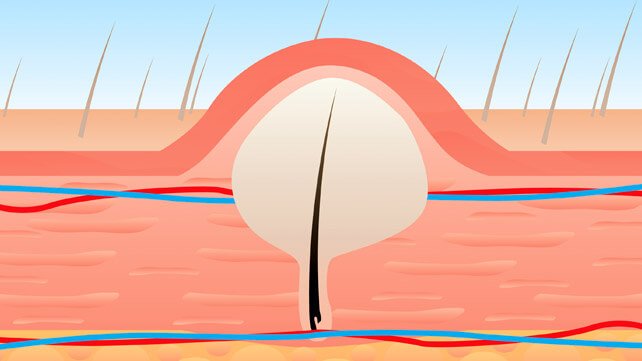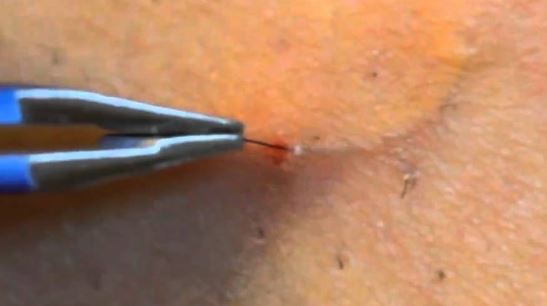Ingrown pubic hair
An ingrown pubic hair is when a previously cut or shaven hair reenters the skin and causes inflammation and infection.
This inflammation of the hair follicle is called folliculitis. The hair follicle could be infected with bacteria, virus, fungal or parasitic types of infections. But most commonly it is noninfectious.
Symptoms of Ingrown pubic hair?
- Often any of the following symptoms are typical for ingrown hairs in the pubic area.
- Itching of the pubic area.
- Mild to moderate pain in the pubic area.
- Long standing or chronic lesions that return frequently.
- Lesions with drainage or puss.
- Blister like lesions
- Scarring from previous lesions. (7)
- Lesions may appear as small, round bumps
- Lesions may appear as darkened skin.
- The pubic area is one of the most common areas for ingrown hairs to appear.
- Ingrown hairs in the pubic area can appear like other more serious conditions and should be diagnosed by a medical professional. (1)
Image Source healthline.com
In this image you can see the inflammation of the dermal tissue. The hair is growing under the skin and causes irritation.
How to Get Rid of Ingrown Pubic Hair?
These methods apply for males and females. They are also useful in which ever area of the body the ingrown hair is found. For example: male pubic area or female bikini lines.
- Most cases do not require treatment, as long as there is no infection or sever pain.
- Most cases will alleviate themselves without treatment when kept clean and dry.
- Some of the most necessary treatments is to obtain from procedures which aggravate the ingrown pubic hair. The following procedures could cause further irritation or infection to form in the ingrown hair. :
- Waxing pubic hair
- Close shaving pubic hair
- Plucking pubic hair
- Do not scratch or pick at ingrown pubic hairs.
- Always wash your hands and the pubic area before examining or touching the ingrown pubic hair.
- Washing the infected area with an exfoliant may help the ingrown hair to return to its proper growth patterns.
- Certain creams may be prescribed such as tretinoin (Renova, Retin-A).
- Help to spead up the clearing away of dead skin cells
- Help to clear away dark skin caused by scaring from irritated ingrown pubic hairs.
- Steroid creams can be applied in the case of extreme inflammation showing as redness, swelling and pain.
- Steroids reduce swelling and irritation around the ingrown hair.
- Antibiotic creams or ointments are necessary if the ingrown hair becomes infected. This is noted if there is a lot of discharge coming form the swollen area.
- If the infection has become systemic then oral antibiotics will be necessary. (2,5,7)
- Trying to remove an ingrown hair on your own is not a good idea. Seek medical attention when necessary.
How can you prevent ingrown pubic hair?
There are many ways to prevent having ingrown pubic hair along the bikini line and for males after shaving.
- Exfoliation is a great way to prevent ingrown pubic hair. This helps to remove dead skin cells and help the hairs pointed in the correct growing positions.
- There are many types of rags, scrunches, or cloths that are sold to help with exfoliation.
- There are many creams, gels, and soaps which contain exfoliation materials.
- Moisturizing products are also an excellent prevention for ingrown pubic hairs. Dry skin is a cause for excessive dead skin cells therefore causing issues with hair growth. Use moisturizers with every shower.
- Avoiding tight underwear and pants also helps to prevent ingrown pubic hairs. Tight underwear and clothing around the groin can cause the growing pubic hairs to grow in the wrong directions. (3,2)
- Avoid removing pubic hair. New pubic hair growth is the leading cause of ingrown pubic hairs.
- Any type of hair removal can cause this miss growth. They include and are not limited to:
- Shaving
- Waxing
- Bikini waxes
- Plucking
- Any type of hair removal can cause this miss growth. They include and are not limited to:
- If you are going to use one of the previous hair removal choices then there are some tips that may help to reduce the amount of ingrown hair.
- Use mild soaps to prevent drying of the skin
- Use only sharp and new razors
- Try laser hair removal. It is expensive but is a longer lasting attempt at pubic hair removal.
- Try non razor hair removal systems such as:
- Hair removal chemicals
- Prescriptions creams to prevent regrowth.
- Electrolysis- use of electrodes to destroy the root of the hair. (2)
Below is an image showing plucking of pubic hair.
Image soruce – healthmds.org
References:
- http://www.mayoclinic.org/diseases-conditions/ingrown-hair/basics/symptoms/con-20034717
- http://www.healthline.com/health/treating-preventing-ingrown-vaginal-hair
- http://www.just-health.net/Ingrown-Hair-In-Pubic-Area.html
- http://www.healthmds.org/hair/ingrown-hair/how-to-remove-ingrown-hair-deep-ingrown-hair-removal-bumps-scars-face-neck-armpit-pubic-vagina/
- http://www.mayoclinic.org/diseases-conditions/ingrown-hair/basics/symptoms/con-20034717
- http://emedicine.medscape.com/article/1071251-overview#a4
- http://emedicine.medscape.com/article/1070456-overview
Published by Dr. Raj MD under Diseases and Conditions.
Article was last reviewed on August 6th, 2018.



